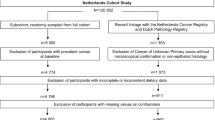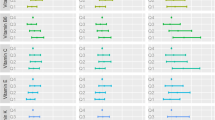A case-control study of women with incident in situ and invasive cervical cancer was conducted during 1982–83 in five US areas reporting to the Comprehensive Cancer Patient Data System: Birmingham, AL; Chicago, IL; Denver, CO; Miami, FL; and Philadelphia, PA. Controls were selected by random-digit dialing and matched to invasive cases on age, race, and telephone exchange. Of the white non-Hispanic in situ cases and controls identified, 229 (78 percent) and 502 (74 percent) were successfully interviewed. Diet was assessed by asking about the usual adult frequency of consumption of 75 food items and the use of vitamin supplements. Included were the major sources of the four micronutrients postulated to reduce the risk of cervical cancer: carotenoids, vitamin A, vitamin C, and folate. Weak inverse associations between risk of in situ disease and intake of carotenoids, vitamin C, folate, fruit, and vegetables/fruits were noted but, with further analysis, these seemed attributable to residual confounding by the multiple lifestyle-related risk factors for this disease and possibly to selection bias. Vitamin A and vegetable intake were unrelated to risk. Dark yellow-orange vegetable consumption and duration of multivitamin use were cach strongly related to reduced risk of in situ disease (P for trend = 0.02 and 0.002, respectively) and need to be evaluated in other studies. The absence of persuasive protective effects for the four micronutrients and the similar findings from our analysis of invasive cervical cancer do not concur with other epidemiologic studies and suggest that the role of diet and nutrition in the etiology of cervical cancer is not yet resolved.
Similar content being viewed by others
References
Ziegler RG, Brinton LA, Hamman RF, et al. Diet and the risk of invasive cervical cancer among white women in the United States. Am J Epidemiol 1990; 132: 432–45.
Hirayama T. Diet and cancer. Nutr Cancer 1979; 1: 67–81.
Wassertheil-Smoller S, Romney SL, Wylie-Rosett J, et al. Dietary vitamin C and uterine cervical dysplasia. Am J Epidemiol 1981; 114: 714–24.
Romney SL, Palan PR, Duttagupta C, et al. Retinoids and the prevention of cervical dysplasias. Am J Obstet Gynecol 1981; 141: 890–4.
Lambert B, Brisson G, Bielmann P. Plasma vitamin A and precancerous lesions of cervix uteri: A preliminary report. Gynecol Oncol 1981; 11: 136–9.
Butterworth CEJr, Hatch KD, Gore H, Mueller H, Krumdieck CL. Improvement in cervical dysplasia associated with folic acid therapy in users of oral contraceptives. Am J Clin Nutr 1982; 35: 73–82.
Marshall JR, Graham S, Byers T, Swanson M, Brasure J. Diet and smoking in the epidemiology of cancer of the cervix. JNCI 1983; 70: 847–51.
Bernstein A, Harris B. The relationship of dietary and serum vitmin A to the occurrence of cervical intraepithelial neoplasia in sexually active women. Am J Obstet Gynecol 1984; 148: 309.
La Vecchia C, Franceschi S, Decarli A, et al. Dietary vitamin A and the risk of invasive cervical cancer. Int J Cancer 1984; 34: 319–22.
Wylie-Rosett JA, Romney SL, Slagle NS, et al. Influence of vitamin A on cervical dysplasia and carcinoma in situ. Nutr Cancer 1984; 6: 49–57.
Orr JWJr, Wilson K, Bodiford C, et al. Nutritional status of patients with untreated cervical cancer II. Vitamin assessment. Am J Obstet Gynecol 1985; 151: 632–5.
Romney DL, Duttagupta C, Basu J, et al. Plasma vitamin C and uterine cervical dysplasia. Am J Obstet Gynecol 1985; 151: 976–80.
Harris RWC, Forman D, Doll R, Vessey MP, Wald NJ. Cancer of the cervix uteri and vitamin A. Br J Cancer 1986; 53: 653–9.
Heinonen PK, Kuoppala T, Koskinen T, Punnonen R. Serum vitamins A and E and carotene in patients with gynecologic cancer. Arch Gynecol Obstet 1987; 241: 151–6.
Romney SL, Basu J, Vermund S, Palan PR, Duttagupta C. Plasma reduced and total ascorbic acid in human uterine cervix dysplasia and cancer. Annals NY Acad Sci 1987; 498: 132–43.
Janik P, Stelmachow J, Sawicki J, Swietochowska B, Kwasniewsky SW, Panek G. Serum retinol level in patients with pre and malignant lesions of female genital tract. Eur J Gynaec Oncol 1987; 8: 595–7.
Palan PR, Romney SL, Mikhail M, Basu J. Decreased plasma beta-carotene levels in women with uterine cervical dysplasias and cancer. JNCI 1988; 80: 454–5.
Brock KE, Berry G, Mock PA, MacLennan R, Truswell AS, Brinton LA. Nutrients in diet and plasma and risk of in situ cervical cancer. JNCI 1988; 80: 580–5.
La Vecchia C, Decarli A, Fasoli M, et al. Dietary vitamin A and the risk of intraepithelial and invasive cervical neoplasia. Gynecol Oncol 1988; 30: 187–95.
Jones CJ, Brinton LA, Hamman RF, et al. Risk factors for in situ cervical cancer: Results from a case-control study. Cancer Res 1990; 50: 3657–62.
Waksberg J. Sampling methods of random digit dialing. J Am Stat Assoc 1978; 73: 40–6.
Hartge P, Brinton LA, Rosenthal JF, Cahill JI, Hoover RN, Waksberg J. Random digit dialing in selecting a population-based control group. Am J Epidemiol 1984; 120: 825–33.
Brinton LA, Schairer C, Haenszel W, et al. Cigarette smoking and invasive cervical cancer. JAMA 1986; 255: 3265–9.
National Center for Health Statistics. Plan and operation of the second National Health and Nutrition Examination Survey, 1976–1980, Vital and Health Statistics. Programs and Collection Procedures. Series 1 Number 15. Hyattsville, MD; US DHHS, 1981.
US Department of Agriculture. Composition of Foods. Agriculture Handbook No. 8. Washington, DC: US GPO, 1963.
National Academy of Sciences. Recommended Dietary Allowances, 9th revised edn. Washington, DC: NAS, 1980.
US Department of Agriculture. Composition of Foods. Agriculture Handbooks Nos. 8–1 to 8–16. Washington, DC: US GPO, 1976–1986.
Subar AF, Block G, James LD. Folate intake and food sources in the US population. Am J Clin Nutr 1989; 50: 508–16.
Breslow NE, Day NE. Statistical Methods in Cancer Research. Vol. 1. The Analysis of Case-Control Studies. Lyon: International Agency for Research on Cancer, 1980; IARC Sci. Pub. No. 32.
US Department of Commerce. 1980 Census of Population. Washington, DC: USGPO, 1982–1984.
Ziegler RG, Mason TJ, Stemhagen A, et al. Carotenoid intake, vegetables, and the risk of lung cancer among white men in New Jersey. Am J Epidemiol 1986; 123: 1080–93.
Whitehead N, Reyner F, Lindenbaum J. Megaloblastic changes in the cervical epithelium: Association with oral contraceptive therapy and reversal with folic acid. JAMA 1973; 226: 1421–4.
Brinton LA, Huggins GR, Lehman HF, et al. Long-term use of oral contraceptives and risk of invasive cervical cancer. Int J Cancer 1986; 38: 339–44.
Koutsky LA, Galloway DA, Holmes KK. Epidemiology of genital human papilomavirus infection. Epidemiol Revs 1988; 10: 122–63.
Micozzi MS, Beecher GR, Taylor PR, Khachik F. Carotenoid analyses of selected raw and cooked foods associated with a lower risk for cancer. JNCI 1990; 82: 282–5.
Sturgeon S, Ziegler RG, Brinton LA, Nasca P, Mallin K. Diet and the risk of vulvar cancer. Ann Epidemiol 1991; in press.
Ziegler RG. Vegetables, fruits, and carotenoids and the risk of cancer. Am J Clin Nutr 1991; in press.
Verrault R, Chu J, Mandelson M, Shy K. A case-control study of diet and invasive cervical cancer. Int J Cancer 1989; 43: 1050–4.
Slattery ML, Abbott TM, Overall JCJr, et al. Dietary vitamins A, C, and E and selenium as risk factors for cervical cancer. Epidemiology 1990; 1: 8–15.
Harris RWC, Brinton LA, Cowdell RH, et al. Characteristics of women with dysplasia or carcinoma in situ of the cervix uteri. Br J Cancer 1980; 42: 359–69.
Author information
Authors and Affiliations
Rights and permissions
About this article
Cite this article
Ziegler, R.G., Jones, C.J., Brinton, L.A. et al. Diet and the risk of in situ cervical cancer among white women in the United States. Cancer Causes Control 2, 17–29 (1991). https://doi.org/10.1007/BF00052357
Received:
Accepted:
Issue Date:
DOI: https://doi.org/10.1007/BF00052357




